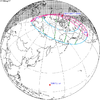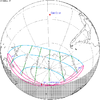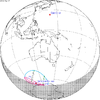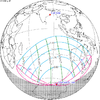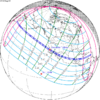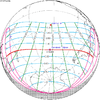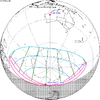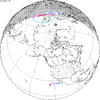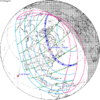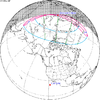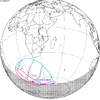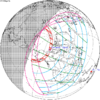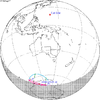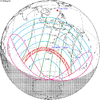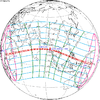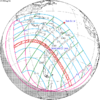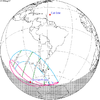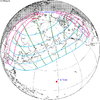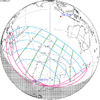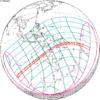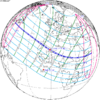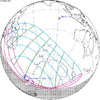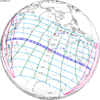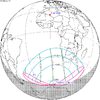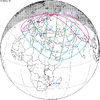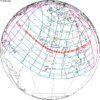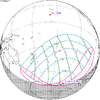List of solar eclipses in the 20th century
| Lists of solar eclipses |
|---|
 |
| Solar eclipses in antiquity |
| Solar eclipses in the Middle Ages |
| Modern history |
| The future |
| Eclipses seen from |
| See also Lists of lunar eclipses |

During the 20th century, there were 228 solar eclipses of which 78 were partial, 73 were annular, 71 were total and 6 were hybrids between total and annular eclipses. Of these, two annular and three total eclipses were non-central,[1] in the sense that the very center (axis) of the Moon's shadow will miss the Earth (for more information see gamma).[2] In the 20th century, the greatest number of eclipses in one year is five, in 1935, though the years 1917, 1946, 1964, 1982 and 2000 had four eclipses each. One month, July 2000, featured two solar eclipses, on July 1 and July 31. The predictions given here are by Fred Espenak of NASA's Goddard Space Flight Center.[1]
The longest measured duration in which the Moon completely covered the Sun, known as totality, was during the solar eclipse of June 20, 1955. This total solar eclipse had a maximum duration of 7 minutes and 7.74 seconds. The longest possible duration of a total solar eclipse is 7 minutes and 32 seconds. The longest annular solar eclipse of the 20th century took place on December 14, 1955, with a duration of 12 minutes and 9.17 seconds. The maximum possible duration is 12 minutes and 29 seconds. Two instances of back-to-back hybrid solar eclipses within a period of less than six months occurred in the 20th century. The eclipse of June 17, 1909, was the second hybrid eclipse in the span of less than one year, the first one being on December 23, 1908, and the eclipse of March 29, 1987, was the second hybrid eclipse in the span of less than one year, the first one being on October 3, 1986.[a]
The table contains the date and time of the greatest eclipse (in dynamical time), which in this case is the time when the axis of the Moon's shadow cone passes closest to the centre of Earth; this is in (Ephemeris Time). The number of the saros series that the eclipse belongs to is given, followed by the type of the eclipse (either total, annular, partial or hybrid), the gamma of the eclipse (how centrally the shadow of the Moon strikes the Earth), and the magnitude of the eclipse (the fraction of the Sun's diameter obscured by the Moon). For total and annular eclipses, the duration of the eclipse is given, as well as the location of the greatest eclipse (the point of maximum eclipse) and the path width of the total or annular eclipse. The geographical areas from which the eclipse can be seen are listed along with a chart illustrating each eclipse's respective path.[3]
Notable eclipses of the 20th century
[edit]- May 29, 1919: this total eclipse was photographed by Arthur Eddington to verify general relativity (see Eddington experiment)[4]
- June 20, 1955: longest total eclipse between 1901 and 2000, lasting a maximum of 7 minutes and 8 seconds[a]
- June 30, 1973: a Concorde jet flew along the path, thereby extending the length of totality to 74 min.[5]
- March 29, 1987: second hybrid eclipse in less than one year, the first being on October 3, 1986.[citation needed]
- July 11, 1991: solar eclipse with the shortest gamma, of only −0.00412.[citation needed]
- July 31, 2000: the second solar eclipse within one calendar month, the first being on July 1, 2000.
Eclipses
[edit]See also
[edit]References
[edit]- ^ a b "Five Million Catalog of Solar Eclipses". NASA. Archived from the original on 11 February 2012. Retrieved 2 August 2008.
- ^ "Glossary of Solar Eclipse Terms". NASA. 13 March 2008. Archived from the original on 18 August 2019. Retrieved 31 August 2008.
- ^ "Key to Catalog of Solar Eclipses". NASA. Archived from the original on 22 March 2019. Retrieved 2 August 2008.
- ^ F. W. Dyson, A. S. Eddington, and C. Davidson, "A Determination of the Deflection of Light by the Sun's Gravitational Field, from Observations Made at the Total Eclipse of May 29, 1919" Philosophical Transactions of the Royal Society of London. Series A, Containing Papers of a Mathematical or Physical Character (1920): 291–333, on 332.
- ^ Mulkin, Barb (1981). "In Flight: The Story of Los Alamos Eclipse Missions, p.42" (PDF). Los Alamos National Laboratory. Retrieved 14 July 2010.
- ^ a b c d e f g h i j k l m n o p q r s t u v w "Solar Eclipses: 1901–1910". NASA. 27 March 2008. Archived from the original on 30 May 2008. Retrieved 28 July 2024.
- ^ a b c d e f g h i j k l m n o p q r s t u v w x "Solar Eclipses: 1911–1920". NASA. 27 March 2008. Archived from the original on 30 May 2008. Retrieved 28 July 2024.
- ^ a b c d e f g h i j k l m n o p q r s t u v w "Solar Eclipses: 1921–1930". NASA. 27 March 2008. Archived from the original on 30 May 2008. Retrieved 28 July 2024.
- ^ a b c d e f g h i j k l m n o p q r s t u v w x "Solar Eclipses: 1931–1940". NASA. 27 March 2008. Archived from the original on 30 May 2008. Retrieved 28 July 2024.
- ^ a b c d e f g h i j k l m n o p q r s t u v w "Solar Eclipses: 1941–1950". NASA. 27 March 2008. Archived from the original on 30 May 2008. Retrieved 28 July 2024.
- ^ a b c d e f g h i j k l m n o p q r s t u v "Solar Eclipses: 1951–1960". NASA. 27 March 2008. Archived from the original on 30 May 2008. Retrieved 28 July 2024.
- ^ a b c d e f g h i j k l m n o p q r s t u v "Solar Eclipses: 1961–1970". NASA. 27 March 2008. Archived from the original on 30 May 2008. Retrieved 28 July 2024.
- ^ a b c d e f g h i j k l m n o p q r s t u v "Solar Eclipses: 1971–1980". NASA. 27 March 2008. Archived from the original on 30 May 2008. Retrieved 28 July 2024.
- ^ a b c d e f g h i j k l m n o p q r s t u v "Solar Eclipses: 1981–1990". NASA. 27 March 2008. Archived from the original on 30 May 2008. Retrieved 28 July 2024.
- ^ a b c d e f g h i j k l m n o p q r s t u v w "Solar Eclipses: 1991–2000". NASA. 27 March 2008. Archived from the original on 30 May 2008. Retrieved 28 July 2024.
Bibliography
[edit]- "Catalog of Solar Eclipses: 1901 to 2000". NASA. Archived from the original on 18 January 2019. Retrieved 27 July 2024.














